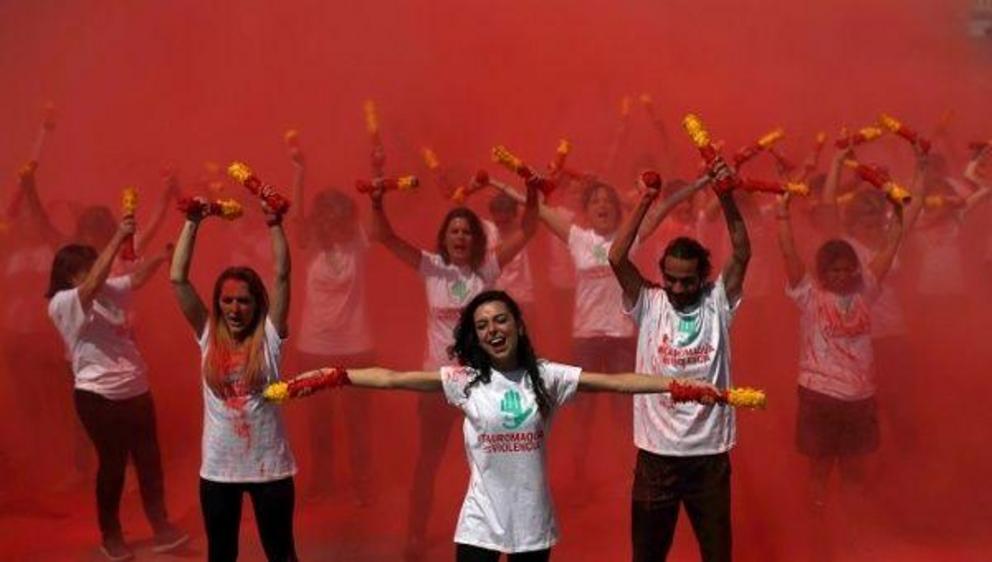40,000 march against bullfighting in Madrid
The bloodsport is trembling in its own cradle.
Madrid's Puerta del Sol (Gate of the Sun) was filled by tens of thousands of “Anti-Taurinos” Sunday, gathered to protest against bullfighting in the cradle of the bloody “sport.”
People gathered to demand the end of bullfighting and any other activity involving cruel treatment of the animals, such as the “encierros” (running of the bulls), in which distressed bulls are let loose in the streets of a town and a group of people run in front of them, or the “todo embolado” (bull with balls), a similar practice in which balls lit on fire are placed on the bull's horns.
“We're including every popular festivity in the demands because we know that animal suffering is terrible even if there's not blood. Prohibiting the killing of the Toro de la Vega was a step forward, but even in the running of the bulls, that might seem harmless, there's mistreatment,” said Laura Gonzalaz, spokeswoman of “Tauromaquia es Violencia” (Bullfighting is Violence), an alliance of animal rights organizations that opposed these practices.
In 2016, the government of Castilla and Leon prohibited the death of the bull in public in the Toro de la Vega Tournament, a festivity celebrated in Tordesillas in which the bull used to be chased by people throwing spears at it until it died. The festivity still takes place, but now the bull is taken somewhere else to be killed, away from the sight of the public.
Animal rights supporters prepare to break mock banderillas containing red powder, during a demonstration against bullfighting in Madrid, Spain, May 27, 2018. Photo | Reuters
“We're totally against the suffering related to these kind of events: a physical effort for which they're not prepared, stress in the event and its transportation, besides many times they end up dead. A lot of people think that it's something harmless, but, for example, in the Sanfermines the bulls in the running end up in the square and dead,” Gonzalez continued.
The protest kicked off at the Puerta del Sol with a performance in which demonstrators broke banderillas, the sticks stabbed in the bull's back, releasing a powder that formed red clouds for a moment. They later left for a march that included a visit to the House of Representatives, at which they yelled “shame.”
Tauromaquia es Violencia is integrated by 11 national and international organizations, including as Animal Guardians, AnimaNaturalis, the Bullfighting and Animal Mistreatment Abolitionist Veterinarian Association , CAS International, Anti-Taurino and Animalist Collective of Bizkaia, Gladiators for Peace, No to Bull Running, Torture Is Not Culture Platform, STOP Bullfighting Platform, Piztiak and Wings of Heart Sanctuary, as well as more than 170 animal rights associations, refugees, NGOs and political parties.
According to the Spanish magazine El Salto, people are increasingly abandoning bullfighting and feeling uncomfortable with it. In 2017, 76 percent of the bullfighting squares were used for other events than their original purpose, bullfighting events decreased 57 percent and 10 provinces have not celebrated any festivity related to bulls since 2016. Besides, 84 percent of people between 16 and 24 years old said they're not proud of these activities.
“We're convinced that bullfighting will end, but there are some sectors that keep it alive artificially, by injecting money with subsidies or trying to secure a new generation of fans with bullfighting schools,” said Gonzalez.
Whether in Spain, where everything started, or in Portugal, France, or in Latin American nations that were colonized by these countries and now have to deal with their “cultural heritage,” parts of those societies are still fascinated by the bloodsport.
In Spain, bullfighting is protected by the Cultural Interest Good declaration, which considers the bloodsport a tradition. The declaration has become a target of animal rights activists trying to revoke it and start legislation against bullfighting, such as prohibiting subsidies or preventing minors from attending the events.
But activists in Spanish territories are confident that bullfighting will end in the next few years, as the anti-taurino movement keeps getting more supporters with time.

